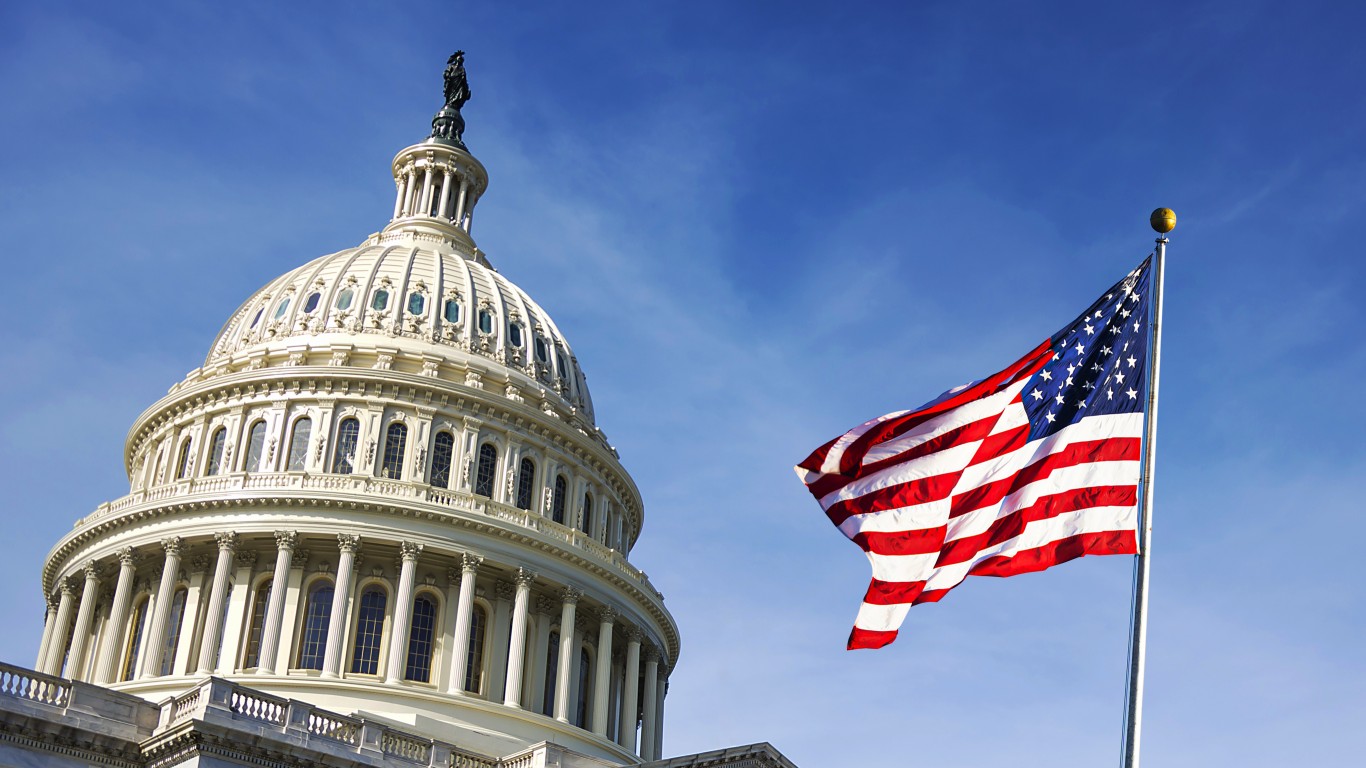
Public employee pension systems are some of the largest financial liabilities on state government balance sheets. The 50 states have over $4.5 trillion in cumulative pension liabilities combined, roughly double the total amount all 50 states spent in fiscal 2020. For years, state pension systems were woefully underfunded in much of the country, but according to a recent report from the Pew Charitable Trusts, this trend may be reversing.
Driven by higher investment from both employees and employers, state pension systems have largely stabilized as of 2020. Since 2007, states across the country have more than doubled annual pension contributions, often cutting funding for other programs to do so.
Still, some states are better positioned to pay public sector employees throughout retirement than others. Using 2020 data compiled by Pew, 24/7 Wall St. reviewed the on-hand financial assets states have in their pension system as a share of their total projected liabilities – or the amount they will have to pay former public sector employees throughout their retirement. States are ranked from the best funded pensions to the worst.
Depending on the state, the share of funded pension obligations ranges from over 100% to less than 40%. As of 2020, half of all states had funding for at least 70% of their total projected obligations.
In contrast to 401(k) retirement plans, which have largely supplanted pensions in the private sector, pensions promise a specified monthly income to retirees for the rest of their life. Under this system, the burden of risk falls on the employer. Public sector workers, such as firefighters, police officers, and teachers, account for a considerable share of the workforce in parts of the country — and for many of them, pensions are critical to financial security throughout retirement. (Here is a look at the best and worst states for healthy retirement.)
It is important to note that 2020 is the most recent year for which comprehensive state level data is available, and the recent market downturn has all but erased much of the financial gains states have made in recent years. Still, while markets are always susceptible to turmoil, improved policies have gone a long way to improving pension funding in much of the country. (Here is a look at the most and least federally dependent states.)
Click here to see how secure public pensions are in every state.
Click here to read our detailed methodology.

50. Wisconsin
> Pension obligations funded: 105.3%
> Pension assets: $125.0 billion (6th highest)
> Pension liabilities: $118.7 billion (11th highest)
> State government workers: 3.2% of workforce – 10th lowest (91,500 total)
[in-text-ad]

49. South Dakota
> Pension obligations funded: 100.0%
> Pension assets: $12.3 billion (8th lowest)
> Pension liabilities: $12.3 billion (5th lowest)
> State government workers: 4.0% of workforce – 24th lowest (17,600 total)

48. Tennessee
> Pension obligations funded: 98.1%
> Pension assets: $41.9 billion (23rd highest)
> Pension liabilities: $42.7 billion (19th lowest)
> State government workers: 3.0% of workforce – 8th lowest (93,900 total)

47. Utah
> Pension obligations funded: 96.6%
> Pension assets: $39.0 billion (25th highest)
> Pension liabilities: $40.4 billion (17th lowest)
> State government workers: 5.0% of workforce – 13th highest (80,600 total)
[in-text-ad-2]

46. Washington
> Pension obligations funded: 95.1%
> Pension assets: $105.1 billion (7th highest)
> Pension liabilities: $110.6 billion (12th highest)
> State government workers: 4.2% of workforce – 24th highest (140,500 total)

45. Nebraska
> Pension obligations funded: 91.8%
> Pension assets: $15.6 billion (11th lowest)
> Pension liabilities: $17.0 billion (8th lowest)
> State government workers: 4.2% of workforce – 23rd highest (42,200 total)
[in-text-ad]

44. Idaho
> Pension obligations funded: 89.1%
> Pension assets: $17.9 billion (14th lowest)
> Pension liabilities: $20.1 billion (12th lowest)
> State government workers: 3.7% of workforce – 21st lowest (29,800 total)

43. North Carolina
> Pension obligations funded: 86.7%
> Pension assets: $103.2 billion (8th highest)
> Pension liabilities: $119.0 billion (10th highest)
> State government workers: 4.4% of workforce – 19th highest (201,700 total)

42. New York
> Pension obligations funded: 86.2%
> Pension assets: $198.1 billion (2nd highest)
> Pension liabilities: $229.9 billion (4th highest)
> State government workers: 2.7% of workforce – 5th lowest (247,400 total)
[in-text-ad-2]

41. Delaware
> Pension obligations funded: 85.2%
> Pension assets: $10.8 billion (6th lowest)
> Pension liabilities: $12.7 billion (6th lowest)
> State government workers: 7.2% of workforce – 3rd highest (32,500 total)

40. Iowa
> Pension obligations funded: 82.9%
> Pension assets: $34.9 billion (24th lowest)
> Pension liabilities: $42.1 billion (18th lowest)
> State government workers: 4.3% of workforce – 20th highest (66,300 total)
[in-text-ad]

39. Maine
> Pension obligations funded: 82.5%
> Pension assets: $15.1 billion (9th lowest)
> Pension liabilities: $18.4 billion (10th lowest)
> State government workers: 3.9% of workforce – 22nd lowest (23,900 total)

38. Ohio
> Pension obligations funded: 81.7%
> Pension assets: $174.2 billion (4th highest)
> Pension liabilities: $213.3 billion (6th highest)
> State government workers: 3.1% of workforce – 9th lowest (164,100 total)

37. West Virginia
> Pension obligations funded: 80.8%
> Pension assets: $15.9 billion (12th lowest)
> Pension liabilities: $19.6 billion (11th lowest)
> State government workers: 6.7% of workforce – 4th highest (45,900 total)
[in-text-ad-2]

36. Minnesota
> Pension obligations funded: 80.7%
> Pension assets: $71.2 billion (14th highest)
> Pension liabilities: $88.3 billion (17th highest)
> State government workers: 3.4% of workforce – 17th lowest (97,600 total)

35. Wyoming
> Pension obligations funded: 78.6%
> Pension assets: $9.6 billion (5th lowest)
> Pension liabilities: $12.3 billion (4th lowest)
> State government workers: 5.1% of workforce – 11th highest (14,300 total)
[in-text-ad]

34. Georgia
> Pension obligations funded: 77.3%
> Pension assets: $97.9 billion (9th highest)
> Pension liabilities: $126.8 billion (9th highest)
> State government workers: 3.4% of workforce – 15th lowest (155,300 total)

33. Nevada
> Pension obligations funded: 77.0%
> Pension assets: $46.7 billion (22nd highest)
> Pension liabilities: $60.7 billion (23rd highest)
> State government workers: 2.9% of workforce – 6th lowest (39,100 total)

32. Oregon
> Pension obligations funded: 75.8%
> Pension assets: $68.3 billion (15th highest)
> Pension liabilities: $90.1 billion (16th highest)
> State government workers: 2.3% of workforce – the lowest (42,400 total)
[in-text-ad-2]

31. Missouri
> Pension obligations funded: 75.4%
> Pension assets: $59.9 billion (17th highest)
> Pension liabilities: $79.5 billion (20th highest)
> State government workers: 3.5% of workforce – 18th lowest (100,700 total)

30. Arkansas
> Pension obligations funded: 75.3%
> Pension assets: $27.7 billion (17th lowest)
> Pension liabilities: $36.8 billion (16th lowest)
> State government workers: 6.0% of workforce – 6th highest (76,400 total)
[in-text-ad]

29. Florida
> Pension obligations funded: 74.5%
> Pension assets: $161.9 billion (5th highest)
> Pension liabilities: $217.5 billion (5th highest)
> State government workers: 2.7% of workforce – 4th lowest (240,300 total)

28. Virginia
> Pension obligations funded: 74.4%
> Pension assets: $79.4 billion (13th highest)
> Pension liabilities: $106.7 billion (14th highest)
> State government workers: 3.9% of workforce – 23rd lowest (154,300 total)

27. Oklahoma
> Pension obligations funded: 73.5%
> Pension assets: $33.2 billion (23rd lowest)
> Pension liabilities: $45.1 billion (21st lowest)
> State government workers: 4.9% of workforce – 15th highest (79,900 total)
[in-text-ad-2]

26. California
> Pension obligations funded: 71.8%
> Pension assets: $495.5 billion (the highest)
> Pension liabilities: $689.9 billion (the highest)
> State government workers: 3.2% of workforce – 11th lowest (534,600 total)

25. Maryland
> Pension obligations funded: 69.9%
> Pension assets: $54.9 billion (20th highest)
> Pension liabilities: $78.6 billion (21st highest)
> State government workers: 4.2% of workforce – 22nd highest (111,700 total)
[in-text-ad]

24. Colorado
> Pension obligations funded: 69.5%
> Pension assets: $58.3 billion (18th highest)
> Pension liabilities: $83.9 billion (18th highest)
> State government workers: 4.5% of workforce – 18th highest (123,800 total)

23. Indiana
> Pension obligations funded: 69.0%
> Pension assets: $31.1 billion (20th lowest)
> Pension liabilities: $45.0 billion (20th lowest)
> State government workers: 3.6% of workforce – 20th lowest (110,900 total)

22. Texas
> Pension obligations funded: 67.5%
> Pension assets: $194.9 billion (3rd highest)
> Pension liabilities: $288.7 billion (2nd highest)
> State government workers: 3.3% of workforce – 12th lowest (424,800 total)
[in-text-ad-2]

21. Alabama
> Pension obligations funded: 67.4%
> Pension assets: $39.4 billion (24th highest)
> Pension liabilities: $58.5 billion (25th highest)
> State government workers: 5.9% of workforce – 8th highest (119,500 total)

20. Montana
> Pension obligations funded: 67.3%
> Pension assets: $11.8 billion (7th lowest)
> Pension liabilities: $17.5 billion (9th lowest)
> State government workers: 5.6% of workforce – 9th highest (27,800 total)
[in-text-ad]

19. Kansas
> Pension obligations funded: 66.3%
> Pension assets: $20.6 billion (15th lowest)
> Pension liabilities: $31.1 billion (14th lowest)
> State government workers: 3.6% of workforce – 19th lowest (49,000 total)

18. Alaska
> Pension obligations funded: 65.6%
> Pension assets: $15.1 billion (10th lowest)
> Pension liabilities: $23.1 billion (13th lowest)
> State government workers: 7.3% of workforce – 2nd highest (22,600 total)

17. Louisiana
> Pension obligations funded: 63.2%
> Pension assets: $35.4 billion (25th lowest)
> Pension liabilities: $55.9 billion (25th lowest)
> State government workers: 4.6% of workforce – 17th highest (86,300 total)
[in-text-ad-2]

16. Arizona
> Pension obligations funded: 61.9%
> Pension assets: $49.6 billion (21st highest)
> Pension liabilities: $80.2 billion (19th highest)
> State government workers: 3.0% of workforce – 7th lowest (88,800 total)

15. Michigan
> Pension obligations funded: 60.4%
> Pension assets: $65.4 billion (16th highest)
> Pension liabilities: $108.2 billion (13th highest)
> State government workers: 4.1% of workforce – 25th highest (172,400 total)
[in-text-ad]

14. Mississippi
> Pension obligations funded: 59.1%
> Pension assets: $28.2 billion (19th lowest)
> Pension liabilities: $47.8 billion (22nd lowest)
> State government workers: 5.0% of workforce – 14th highest (56,600 total)

13. New Hampshire
> Pension obligations funded: 58.8%
> Pension assets: $9.2 billion (4th lowest)
> Pension liabilities: $15.6 billion (7th lowest)
> State government workers: 3.4% of workforce – 14th lowest (22,300 total)

12. Pennsylvania
> Pension obligations funded: 58.5%
> Pension assets: $93.6 billion (10th highest)
> Pension liabilities: $160.0 billion (8th highest)
> State government workers: 2.5% of workforce – 3rd lowest (144,900 total)
[in-text-ad-2]

11. Vermont
> Pension obligations funded: 58.4%
> Pension assets: $4.7 billion (the lowest)
> Pension liabilities: $8.0 billion (the lowest)
> State government workers: 5.9% of workforce – 7th highest (17,300 total)

10. Massachusetts
> Pension obligations funded: 55.9%
> Pension assets: $57.9 billion (19th highest)
> Pension liabilities: $103.6 billion (15th highest)
> State government workers: 3.4% of workforce – 16th lowest (119,800 total)
[in-text-ad]

9. North Dakota
> Pension obligations funded: 55.4%
> Pension assets: $6.0 billion (2nd lowest)
> Pension liabilities: $10.8 billion (2nd lowest)
> State government workers: 5.3% of workforce – 10th highest (21,900 total)

8. Rhode Island
> Pension obligations funded: 54.2%
> Pension assets: $6.6 billion (3rd lowest)
> Pension liabilities: $12.1 billion (3rd lowest)
> State government workers: 4.0% of workforce – 25th lowest (19,400 total)

7. Hawaii
> Pension obligations funded: 53.2%
> Pension assets: $17.4 billion (13th lowest)
> Pension liabilities: $32.7 billion (15th lowest)
> State government workers: 11.5% of workforce – the highest (66,900 total)
[in-text-ad-2]

6. South Carolina
> Pension obligations funded: 51.7%
> Pension assets: $31.3 billion (21st lowest)
> Pension liabilities: $60.4 billion (24th highest)
> State government workers: 5.0% of workforce – 12th highest (107,800 total)

5. New Mexico
> Pension obligations funded: 50.0%
> Pension assets: $27.9 billion (18th lowest)
> Pension liabilities: $55.8 billion (24th lowest)
> State government workers: 6.6% of workforce – 5th highest (53,300 total)
[in-text-ad]

4. Kentucky
> Pension obligations funded: 44.6%
> Pension assets: $24.4 billion (16th lowest)
> Pension liabilities: $54.8 billion (23rd lowest)
> State government workers: 4.7% of workforce – 16th highest (88,200 total)

3. Connecticut
> Pension obligations funded: 42.6%
> Pension assets: $31.8 billion (22nd lowest)
> Pension liabilities: $74.6 billion (22nd highest)
> State government workers: 4.3% of workforce – 21st highest (69,500 total)

2. New Jersey
> Pension obligations funded: 38.4%
> Pension assets: $79.9 billion (12th highest)
> Pension liabilities: $208.2 billion (7th highest)
> State government workers: 3.4% of workforce – 13th lowest (134,900 total)
[in-text-ad-2]

1. Illinois
> Pension obligations funded: 37.5%
> Pension assets: $92.3 billion (11th highest)
> Pension liabilities: $246.2 billion (3rd highest)
> State government workers: 2.5% of workforce – 2nd lowest (142,900 total)
Methodology
To rank every state’s pension crisis, 24/7 Wall St. reviewed the share of each state’s pension obligations that have funding for. All state pension data is for 2020 and was compiled by the Pew Charitable Trusts using comprehensive annual financial reports from each state.
Data on state government employment as a share of total non-farm employment are annual estimates from the Bureau of Labor Statistics and are for 2021.
Thank you for reading! Have some feedback for us?
Contact the 24/7 Wall St. editorial team.
 24/7 Wall St.
24/7 Wall St. 24/7 Wall St.
24/7 Wall St.

